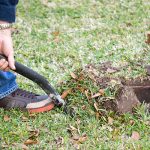It’s winter and your lawn is dormant – so why is your irrigation system running? Using extra water outdoors now only makes your sewer bill bloom later.
OK everyone, let’s have a show of hands to see how many of you are currently running your irrigation systems at least once per week? I’m asking because in my travels through particular areas, I notice a lot of “irrigation signatures” in and down the streets in front of homes, indicating irrigation has run within the past minutes or hours.
First, you must understand that irrigating dormant grass will not make it grow, no matter how hard you try. As long as soil temperatures are below 70 degrees, turf grasses will not produce green shoots. Only the roots of grasses, trees and shrubs are active in the winter. What WILL turn green are the germinating winter weeds like dandelions and henbit, along with cool-season weedy grasses such as rye, fescue, Poa anna or Rescue grass.
Why is NOT irrigating in the winter important? Your sewer bill. SAWS uses the period between Nov. 15 and March 15 each year to calculate your sewer bill for the following year. Why use the winter? Water use for residential customers in the winter is assumed to be primarily occurring indoors, meaning outdoor water use is minimal, if at all.
Normally, a good winter recommendation is to apply ½ inch of water to the landscape every four weeks since the grass/plants are not actively growing. However, a rainfall of ½ inch or more is enough to delay irrigation for at least four weeks in winter.
Soil depth is very important in the water needs of plants and grass for winter. Soil at least six inches deep or more will hold moisture longer, requiring less frequent irrigation or rainfall. Landscapes with soil less than six inches deep may require some kind of irrigation or rainfall at least once every two weeks.
Shrubs and trees require less water than grasses in winter and usually do well on rainfall alone. If water is needed, use a hand-held hose to apply water to individual shrubs and trees once or twice during the winter and use irrigation sparingly on grasses.
While most winters in San Antonio are mild, they’re still cool enough to keep warm season grasses (St. Augustine, Bermuda, zoysia and buffalo) from growing and remaining emerald green. These grasses do not need lots of water to survive the winter. Using extra water outdoors in the winter does nothing but make your sewer bill grow the following year.
Next time you’re in the garage, stop by your irrigation controller and switch it to “off” or “manual” until after March 15.




